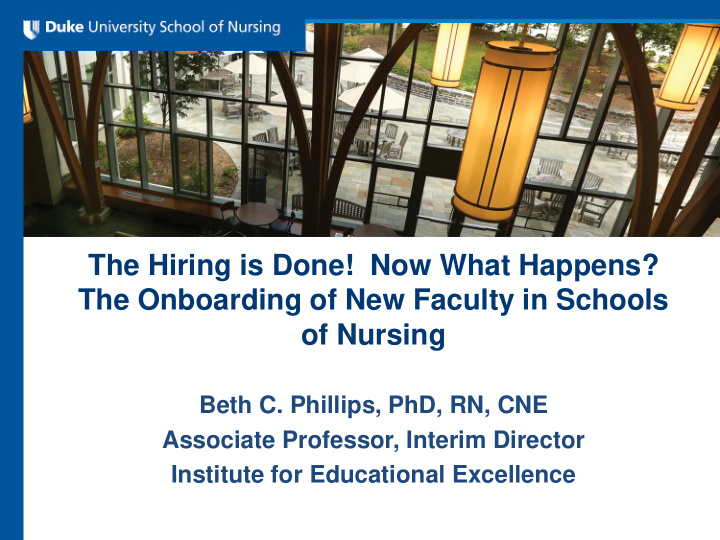



The Hiring is Done! Now What Happens? The Onboarding of New Faculty in Schools of Nursing Beth C. Phillips, PhD, RN, CNE Associate Professor, Interim Director Institute for Educational Excellence
Conflict of Interest There is no perceived or real conflict of interest with this presenter or presentation.
Objectives Understand the importance of successful faculty onboarding and retention Discuss the importance of a structured orientation program for new faculty Explore ways to develop/enhance one’s orientation program Propose concrete solutions to successfully orienting new faculty
The Importance Of Onboarding 1715 64,067 97,083-77,022 9,757 & 2,102
Retention of Faculty Quick Poll lling School Benefits • Cost savings • Quality teaching • Expertise development • Collaboration
Structured Orientation • Builds trust in the organization • Allows for safe questioning and learning • Establishes norms • Ensures basic standards • Provides ongoing support and guidance
Orientation Program • Formal and informal components • Administration participation • Initial Assessment • Monthly meetings • Guidance and direction • Teaching support
Set Mission and Goals • Prepare master teachers who design and implement academic programs that prepare graduates as outstanding clinicians, scholars, and leaders in the field of nursing. • Sustain the school as a center of teaching excellence , known for its innovative academic programs; its conduct of transformative educational research; its commitment to the ongoing development of faculty ; and its exceptional graduates. 8
Mission and Goals, continued • Create a culture of excellence and innovation , as well as a community of learning, where faculty continually seek to become more effective and innovative teachers who serve as role models for students who, themselves, are becoming lifelong learners committed to excellence. • Develop faculty to serve as nursing education leaders and pedagogical scholars who transform nursing education. • Contribute to the development of the science of nursing education. 9
After hire…. • -Individualized plan for each new faculty: Self-Assessments Educator competencies based on the NLN Competencies for Nurse Educators Technology competencies
Educator Competencies 11
Leadership in Higher Education 12 Conference
SELF-ASSESSMENT OF NURSE EDUCATOR COMPETENCIES • Facilitate learning • Facilitate learner development and socialization • Use assessment and evaluation strategies • Participate in curriculum design and evaluation of program outcomes 13
NURSE EDUCATOR COMPETENCIES, continued • Function as a change agent and leader • Pursue continuous quality improvement In the nurse educator role • Engage in scholarship • Function within the educational environment 14
SELF-ASSESSMENT OF EDUCATIONAL TECHNOLOGY COMPETENCIES • Area of competency • Effective use of educational technologies – To help students – To implement principles of good teaching (Chickering & Gamson, 1987) • Ability to create effective learning experiences 15
Faculty Orientation Part 2 - Meeting schedule with key personnel -Guides Pedagogical Scholarship/ Research Culture -Monthly orientation sessions 16
Culture Guide This individual is expected to help new faculty understand the “culture” of the school and university and “how things work”. Pedagogical Guide This individual is expected to help new faculty with their teaching responsibilities. Scholarship Guide (Track II) This individual is expected to help new practice track and research track faculty with their scholarly endeavors. Research Mentor (Track I) This individual is expected to help new tenure track faculty with their program of research. 17
Monthly Orientation Sessions • Facilitated by Faculty • Flexible format – Topics vary based on new faculty needs Last month: Teaching Credits, Advising, student evaluations 18
Evaluation Process • Survey to all participants within 6 months of start date • Re-evaluate processes annually • Note variance in hiring throughout the year
How do you resource this process? • Leader/ Administrative support • Cost • Time • Energy What are the Pay offs??
What about your school? • What works? • What doesn’t work? • What do you want to try? • What will it take?
Commitment to add something new….. • Start small • Have a long term plan • Evaluate the process • Write it down! • Find a partner/ colleague!
Objectives, reviewed Understand the importance of successful faculty onboarding and retention Discuss the importance of a structured orientation program for new faculty Explore ways to develop/enhance one’s orientation program Propose concrete solutions to successfully orienting new faculty
Questions? Comments? • Thank you for coming!!
References • American Association of Colleges of Nursing. (2018). Special survey of AACN membership on vacant faculty positions for academic year 2018-2019. Retrieved from htps://www.aacnnursing.org/ Portals/42/News/Surveys-Data/Vacancy18.pdf • Ross, J.G. & Dunker, K.S. ((2019). New clinical nurse faculty orientation: A review of the literature. Nursing Education Perspectives , doi: 10.1097/01.NEP.0000000000000470. • Lee, P., Miller, M.T., Kippenbrock, T.A., Rosen, C., & Emory, J. (2017). College nursing faculty job satisfaction and retention: A national perspective. Journal of Professional Nursing , 33, 261-266.
Recommend
More recommend